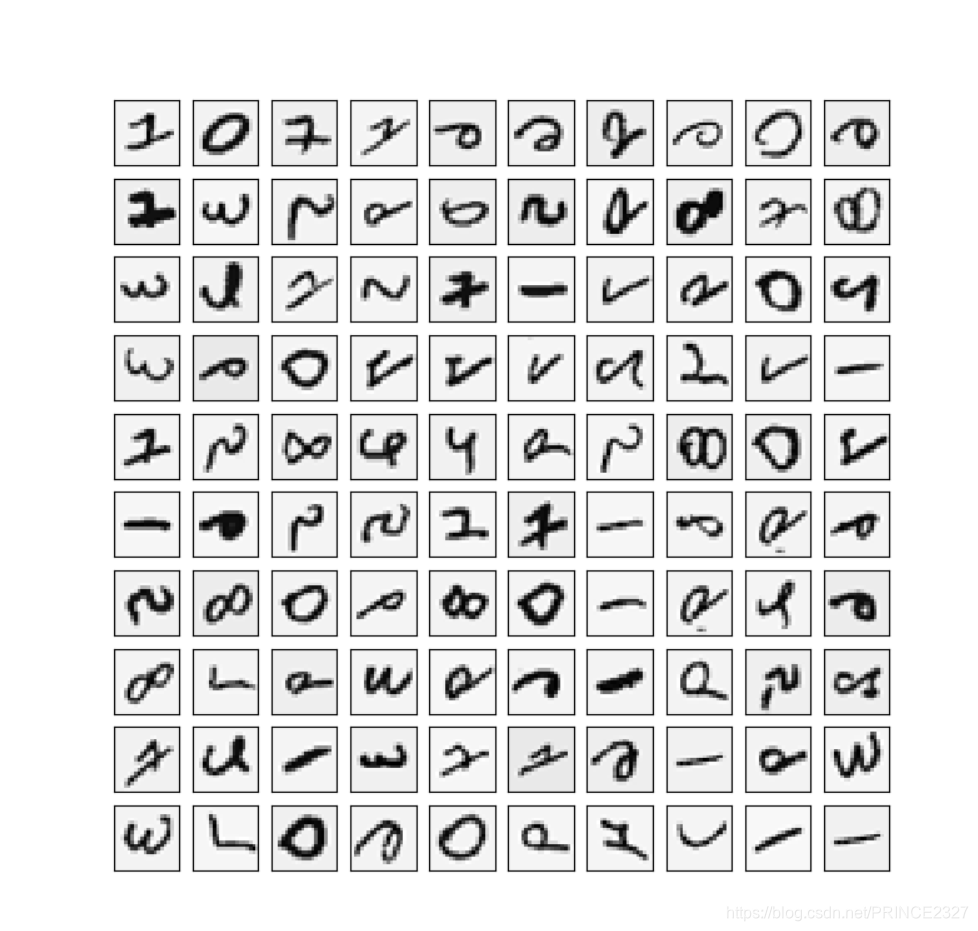Python 3.7
所用数据集链接:反向传播网络所用数据集(ex4data1.mat,ex4weights.mat),提取码:c3yy
目录
- Feedback neural network
- 1.0 Package
- 1.1 Load data
- 1.2 Visualization data
- 1.3 Data preprocess
- 1.4 Load weights
- 1.5 Unrolling data
- 1.6 Deserialize data
- 1.7 Sigmoid function
- 1.8 Sigmoid diff
- 1.9 Feedforward propagation
- 1.10 Costfunction
- 1.11 Regularized costfunction
- 1.12 Gradient function
- 1.13 Regularized gradient
- 1.14 Gradient check
- 1.15 Random initial
- 1.16 Training model
- 1.17 Visualization hidden layer
- 1.18 Evalute model
- 1.19 Apply model
- 1.20 All
Feedback neural network
题目:仍然是手写数字识别,不过本次要求从头开始完整地训练一个神经网络,并且在其中采用反向传播算法减小误差。数据集中的X为(5000,400)的矩阵,即有5000个样本,每个样本选取了400个像素点。y为(5000,1),指明每一个样本类别。
首先导入用到的包:
1.0 Package
import numpy as np
# 数据处理
import matplotlib.pyplot as plt
# 绘图
from scipy.io import loadmat
# 加载矩阵文件
from sklearn.metrics import classification_report
# 分类报告
import scipy.optimize as opt
# 高级优化函数
1.1 Load data
然后读入数据:
def load_data(path):
# 定义函数,传入路径
data=loadmat(path)
# 读取矩阵文件
raw_x=data['X']
raw_y=data['y'].flatten()
# 根据索引读取x,y并将y展开(方便后续与模型预测出的y_pred比较)
return raw_x,raw_y
# 返回
raw_x,raw_y=load_data('ex4data1.mat')
#print(np.unique(raw_y))
# 查看raw_y中一共有几类数据,也就是看分为几类,从而确定输出层激活单元数
# raw_x为(5000,400),raw_y为(5000,)
1.2 Visualization data
下面进行数据的可视化,选取100个样本进行可视化:
def view_data():
# 定义函数
data_index=np.random.randint(0,5000,100)
# 在样本中随机选取100个
data_sample=raw_x[data_index]
# 找到对应样本
fig,ax=plt.subplots(10,10,sharex=True,sharey=True,figsize=(8,8))
# 创建画布和对象,其中前两个参数是指对象在画布上的分布,也即10行10列
# 注意此时的ax是一个数组
for i in range(10):
for j in range(10): ax[i,j].matshow(data_sample[10*i+j].reshape(20,20),cmap='gray_r')
# 绘制矩阵,记得把样本reshape成(20,20)的
plt.xticks([])
plt.yticks([])
# 去掉坐标轴
plt.show()
# 可视化
view_data()
结果如下:

1.3 Data preprocess
下面进行数据预处理:
def data_preprocess(raw_x,raw_y):
# 定义函数,传入参数
x=np.insert(raw_x,0,1,axis=1)
# 加一列1,向量化
y=[]
for i in raw_y:
y_array=np.zeros(10)
y_array[i-1]=1
y.append(y_array)
# 将y转换为独热编码
return x,np.array(y)
# 返回处理后的x,y(记得把y的类型设置成数组)
x,y=data_preprocess(raw_x,raw_y)
print(x.shape,y.shape)
# 查看形状 (5000,401),(5000,10)
1.4 Load weights
加载给定的权重(只是为了看看形状,后续还是需要我们自己训练网络权重):
def load_weight(path):
# 定义函数,传入参数
data=loadmat(path)
# 读取矩阵文件
theta1=data['Theta1']
theta2=data['Theta2']
# 根据索引值区分theta1和theta2
return theta1,theta2
theta1,theta2=load_weight('ex4weights.mat')
print(theta1.shape,theta2.shape)
# 查看形状 (25,401),(10,26)
1.5 Unrolling data
下面定义序列化函数,可以用来展开数组:
def unrolling(theta1,theta2):
# 定义函数,传入参数
theta=np.r_[theta1.flatten(),theta2.flatten()]
# 将theta1,theta2展开再合并
return theta
theta=unrolling(theta1,theta2)
print(theta.shape)
# (10285,)
1.6 Deserialize data
展开是为了在优化函数中传入向量,但其它地方我们也需要矩阵形式的参数,故再定义解序列化函数:
def deserialize(theta):
# 定义函数,传入从参数
theta1=theta[:25*401].reshape(25,401)
# 取前25*401个数恢复成25*401的数组(二维数组)
theta2=theta[25*401:].reshape(10,26)
# 同上
return theta1,theta2
theta1,theta2=deserialize(theta)
1.7 Sigmoid function
定义激活函数:
def sigmoid(z):
return 1/(1+np.exp(-z))
1.8 Sigmoid diff
定义激活函数倒数,后续在反向传播时候会用到:
def sigmoid_gradient(z):
return sigmoid(z)*(1-sigmoid(z))
# 导数与原函数的关系读者可自行推导
1.9 Feedforward propagation
开始前向传播:

def feedforward(theta,x):
theta1,theta2=deserialize(theta)
a1=x
z2=a1@theta1.T
a2=np.insert(sigmoid(z2),0,1,axis=1)
z3=a2@theta2.T
h=sigmoid(z3)
return a1,z2,a2,z3,h
# 具体公式见上图
1.10 Costfunction
定义代价函数:

def costfunction(theta,x,y):
# 定义函数
a1,z2,a2,z3,h=feedforward(theta,x)
# 导入前向传播的参数
cost=-y*np.log(h)-(1-y)*np.log(1-h)
return cost.sum()/len(x)
# 计算代价函数
cost=costfunction(theta,x,y)
#print(cost) #读取的权重对应的值为0.28多
1.11 Regularized costfunction
下面对于代价函数进行正则化:

def regularized_costfunction(theta,x,y,l):
theta1,theta2=deserialize(theta)
reg=np.sum(theta1[:,1:]**2)+np.sum(theta2[:,1:]**2)
return reg*l/(2*len(x))+costfunction(theta,x,y)
re_cost=regularized_costfunction(theta,x,y,1)
# 都是数学公式,很简单
#print(re_cost) #读取的权重对应的值大约为0.38多
1.12 Gradient function
下面定义梯度函数:


def gradient(theta,x,y):
theta1,theta2=deserialize(theta)
a1,z2,a2,z3,h=feedforward(theta,x)
d3=h-y
d2=d3@theta2[:,1:]*sigmoid_gradient(z2)
D2=d3.T@a2
D1=d2.T@a1
D=(1/len(x))*unrolling(D1,D2)
# 计算公式可自行推导,一点微积分就够了。返回的D是展开后的全局梯度
return D
1.13 Regularized gradient
将梯度正则化:

def regularized_gradient(theta,x,y,l):
theta1,theta2=deserialize(theta)
a1,z2,a2,z3,h=feedforward(theta,x)
D1,D2=deserialize(gradient(theta,x,y))
theta1[:,0]=0
theta2[:,0]=0
# 不对theta0正则化
reg_D1=D1+(l/len(x))*theta1
reg_D2=D2+(l/len(x))*theta2
return unrolling(reg_D1,reg_D2)
# 返回正则化后的梯度(展开为一维数组)
1.14 Gradient check
梯度检验,确保梯度函数正确:
def gradient_checking(theta, x, y, e):
def grad(plus, minus):
return (regularized_costfunction(plus, x, y,1) - regularized_costfunction(minus, x, y,1)) / (e * 2)
# 返回粗略计算的梯度
grad = []
for i in range(len(theta)):
plus = theta.copy()
minus = theta.copy()
plus[i] = plus[i] + e
minus[i] = minus[i] - e
grad_i = grad(plus, minus)
ngrad.append(grad_i)
grad = np.array(grad)
# 转换为数组
analytic_grad = regularized_gradient(theta, x, y,1)
# 返回梯度函数计算的梯度
diff = np.linalg.norm(grad - analytic_grad) / np.linalg.norm(grad + analytic_grad)
# 看看两者差别,最多差几位小数
print('nRelative Difference: {}'.format(diff))
gradient_checking(theta, x, y, 0.0001)
顺便说一下,正式跑网络时候梯度检测一定要关掉。
1.15 Random initial
def random_init(size):
return np.random.uniform(-0.1,0.1,size)
# 在-0.1到0.1区间中返回size个数构成一个数组
1.16 Training model
下面开始训练模型:
def training(x, y):
acc=[]
for i in range(200):
init_theta = random_init(10285) # 25*401 + 10*26
res = opt.minimize(fun=regularized_costfunction,
x0=init_theta,
args=(x, y, 1),
method='TNC',
jac=regularized_gradient,
options={'maxiter': i})
_, _, _, _, h = feedforward(res.x,x)
y_pred = np.argmax(h, axis=1) + 1
a=np.mean(y_pred==raw_y)
acc.append(a)
fig,ax=plt.subplots(figsize=(6,6))
ax.plot(np.arange(200),acc)
plt.ylim(0,1.0)
ax.set_xlabel('Iterations')
ax.set_ylabel('Accuracy')
ax.set_title('Iterations VS Accuracy')
plt.show()
return res
result=training(x,y)
print(result)
# 这一部分添加了准确率随迭代次数的关系图,所以运行起来相对比较慢,读者可以去掉画图部分。
输出如下:


看到前期振荡比较剧烈,到后期会好很多。
1.17 Visualization hidden layer
下面可视化隐层:
def visualization_hidden(theta):
theta1,theta2 = deserialize(theta)
theta1 = theta1[:, 1:]
fig,ax_array = plt.subplots(5, 5, sharex=True, sharey=True, figsize=(6,6))
for i in range(5):
for j in range(5):
ax_array[i, j].matshow(theta1[r * 5 + c].reshape(20, 20), cmap='gray_r')
plt.xticks([])
plt.yticks([])
plt.show()
visualization_hidden(result.x)
# 传入的是我们训练好的theta
结果如下:

1.18 Evalute model
下面评估模型:
def accuracy(result, x, y):
_, _, _, _, h = feedforward(result.x,x)
y_pred = np.argmax(h, axis=1) + 1
acc=np.mean(y_pred==y)
print(classification_report(y, y_pred))
# 分别传入真实标签与预测标签
print('accuracy:',np.mean(acc)*100,'%')
accuracy(result,x,raw_y)
结果如下:

1.19 Apply model
应用这个模型只需要写一段程序,可以将手写体图片转换为20*20的灰度图像即可。
1.20 All
下面给出完整代码:
import numpy as np
import matplotlib.pyplot as plt
from scipy.io import loadmat
from sklearn.metrics import classification_report
import scipy.optimize as opt
def load_data(path):
data=loadmat(path)
raw_x=data['X']
raw_y=data['y'].flatten()
return raw_x,raw_y
raw_x,raw_y=load_data('ex4data1.mat')
print(raw_y.shape)
def view_data():
data_index=np.random.randint(0,5000,100)
data_sample=raw_x[data_index]
fig,ax=plt.subplots(10,10,sharex=True,sharey=True,figsize=(8,8))
for i in range(10):
for j in range(10):
ax[i,j].matshow(data_sample[10*i+j].reshape(20,20),cmap='gray_r')
plt.xticks([])
plt.yticks([])
plt.show()
view_data()
def data_preprocess(raw_x,raw_y):
x=np.insert(raw_x,0,1,axis=1)
y=[]
for i in raw_y:
y_array=np.zeros(10)
y_array[i-1]=1
y.append(y_array)
return x,np.array(y)
x,y=data_preprocess(raw_x,raw_y)
print(x.shape,y.shape)
def load_weight(path):
data=loadmat(path)
theta1=data['Theta1']
theta2=data['Theta2']
return theta1,theta2
theta1,theta2=load_weight('ex4weights.mat')
print(theta1.shape,theta2.shape)
def unrolling(theta1,theta2):
theta=np.r_[theta1.flatten(),theta2.flatten()]
return theta
theta=unrolling(theta1,theta2)
print(theta.shape)
def deserialize(theta):
theta1=theta[:25*401].reshape(25,401)
theta2=theta[25*401:].reshape(10,26)
return theta1,theta2
theta1,theta2=deserialize(theta)
def sigmoid(z):
return 1/(1+np.exp(-z))
def sigmoid_gradient(z):
return sigmoid(z)*(1-sigmoid(z))
def feedforward(theta,x):
theta1,theta2=deserialize(theta)
a1=x
z2=a1@theta1.T
a2=np.insert(sigmoid(z2),0,1,axis=1)
z3=a2@theta2.T
h=sigmoid(z3)
return a1,z2,a2,z3,h
def costfunction(theta,x,y):
a1,z2,a2,z3,h=feedforward(theta,x)
cost=-y*np.log(h)-(1-y)*np.log(1-h)
return cost.sum()/len(x)
cost=costfunction(theta,x,y)
#print(cost)
def regularized_costfunction(theta,x,y,l):
theta1,theta2=deserialize(theta)
reg=np.sum(theta1[:,1:]**2)+np.sum(theta2[:,1:]**2)
return reg*l/(2*len(x))+costfunction(theta,x,y)
re_cost=regularized_costfunction(theta,x,y,1)
#print(re_cost)
def random_init(size):
return np.random.uniform(-0.12,0.12,size)
def gradient(theta,x,y):
theta1,theta2=deserialize(theta)
a1,z2,a2,z3,h=feedforward(theta,x)
d3=h-y
d2=d3@theta2[:,1:]*sigmoid_gradient(z2)
D2=d3.T@a2
D1=d2.T@a1
D=(1/len(x))*unrolling(D1,D2)
return D
def regularized_gradient(theta,x,y,l):
# theta1,theta2=deserialize(theta)
a1,z2,a2,z3,h=feedforward(theta,x)
D1,D2=deserialize(gradient(theta,x,y))
theta1[:,0]=0
theta2[:,0]=0
reg_D1=D1+(l/len(x))*theta1
reg_D2=D2+(l/len(x))*theta2
return unrolling(reg_D1,reg_D2)
def gradient_checking(theta, x, y, e):
def grad(plus, minus):
return (regularized_costfunction(plus, x, y,1) - regularized_costfunction(minus, x, y,1)) / (e * 2)
# 返回粗略计算的梯度
grad = []
for i in range(len(theta)):
plus = theta.copy()
minus = theta.copy()
plus[i] = plus[i] + e
minus[i] = minus[i] - e
grad_i = grad(plus, minus)
ngrad.append(grad_i)
grad = np.array(grad)
# 转换为数组
analytic_grad = regularized_gradient(theta, x, y,1)
# 返回梯度函数计算的梯度
diff = np.linalg.norm(grad - analytic_grad) / np.linalg.norm(grad + analytic_grad)
# 看看两者差别,最多差几位小数
print('nRelative Difference: {}'.format(diff))
gradient_checking(theta, x, y, 0.0001)
def training(x, y):
acc=[]
for i in range(20):
init_theta = random_init(10285) # 25*401 + 10*26
res = opt.minimize(fun=regularized_costfunction,
x0=init_theta,
args=(x, y, 1),
method='TNC',
jac=regularized_gradient,
options={'maxiter': i})
_, _, _, _, h = feedforward(res.x,x)
y_pred = np.argmax(h, axis=1) + 1
a=np.mean(y_pred==raw_y)
acc.append(a)
fig,ax=plt.subplots(figsize=(6,6))
ax.plot(np.arange(20),acc)
plt.ylim(0,1.0)
ax.set_xlabel('Iterations')
ax.set_ylabel('Accuracy')
ax.set_title('Iterations VS Accuracy')
plt.show()
return res
result=training(x,y)
print(result)
def accuracy(result, x, y):
_, _, _, _, h = feedforward(result.x,x)
y_pred = np.argmax(h, axis=1) + 1
acc=np.mean(y_pred==y)
print(classification_report(y, y_pred))
print('accuracy:',np.mean(acc)*100,'%')
accuracy(result,x,raw_y)
def visualization_hidden(theta):
theta1,theta2 = deserialize(theta)
theta1 = theta1[:, 1:]
fig,ax_array = plt.subplots(5, 5, sharex=True, sharey=True, figsize=(6,6))
for i in range(5):
for j in range(5):
ax_array[i, j].matshow(theta1[r * 5 + c].reshape(20, 20), cmap='gray_r')
plt.xticks([])
plt.yticks([])
plt.show()
visualization_hidden(result.x)
# 传入的是我们训练好的theta
多加练习。
未经允许,请勿转载。
欢迎交流。





















 4583
4583











 被折叠的 条评论
为什么被折叠?
被折叠的 条评论
为什么被折叠?








